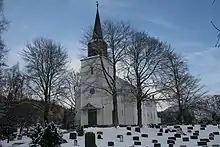Jacob Wilhelm Nordan
Jacob Wilhelm Nordan (23 February 1824 – 11 April 1892) was a Danish-born, Norwegian architect. During his career, he was one of the most prolific church architects in Norway.[1]


Biography
Nordan was born in Copenhagen, Denmark and came to Norway as a child with his mother. He attended the Royal Drafting School (Den Kongelige Tegneskole) in Christiania (now Oslo), where Johannes Flintoe, Christian Heinrich Grosch and Johan Henrik Nebelong were among his teachers. From 1849 to 1852, Nordan worked under architect Johan Henrik Nebelong as assistant and building manager during the construction of Oscarshall. From 1852 to 1855, he studied at the Royal Danish Academy of Fine Arts in Copenhagen and received travel grants to Bavaria and Austria.[2][3]
In 1856, he established architectural office in Christiania, while he also taught at the Royal Drafting School. While working for the Ministry of the Church of Norway, he designed nearly one hundred churches. Among his designs are also Fritzøehus Manor located outside Larvik, the former fire and police station in Oslo at Møllergata 19, and the bazaars on the public square at Youngstorget in downtown Oslo.
In 1860, Nordan married Danish artist Henriette Dorothea Henius (1826-1903). Their son Victor Nordan (1862-1933) was also an architect. He became his father's partner in 1887 and took over the company at his death 1892.[4] [5]
Gallery
 Førde Church in Sogn og Fjordane (1885)
Førde Church in Sogn og Fjordane (1885) Askim Church in Østfold (1878)
Askim Church in Østfold (1878) Thorvald Meyers gate 38 at Grünerløkka (1876)
Thorvald Meyers gate 38 at Grünerløkka (1876) Stavanger Hetlandsbanken in Stavanger (1891)
Stavanger Hetlandsbanken in Stavanger (1891) Former fire and police station at Møllergata 19 (1866)
Former fire and police station at Møllergata 19 (1866) Hustad Church in Fræna (1874)
Hustad Church in Fræna (1874) King Oscar II Chapel at Grense Jakobselv (1869)
King Oscar II Chapel at Grense Jakobselv (1869)
References
- Bjerkek, Ole Petter. "Jacob Wilhelm Nordan". In Godal, Anne Marit (ed.). Store norske leksikon (in Norwegian). Oslo: Norsk nettleksikon. Retrieved 24 March 2014.
- Jens Christian Eldal. "Jacob Wilhelm Nordan". Norsk kunstnerleksikon. Retrieved August 15, 2016.
- "Building Oscarshall Summer Palace". Det Norske Kongehus. Retrieved September 1, 2017.
- "Henriette Dorothea Henius Nordan". Norsk kunstnerleksikon. Retrieved September 1, 2017.
- Bjerkek, Ole Petter. "Jacob Wilhelm Nordan". In Helle, Knut (ed.). Norsk biografisk leksikon (in Norwegian). Oslo: Kunnskapsforlaget. Retrieved 24 March 2014.